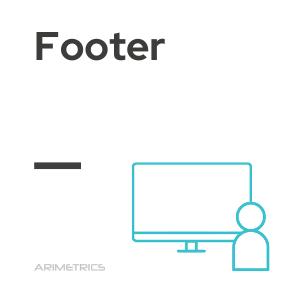 Definition:
Definition:
The footer is the bottom section of a web page, designed to include elements such as navigation links, copyright information, social media buttons and other links of interest. Its main function is to provide additional information that complements the main content of the page. This space is reserved for highlighting information that might have gone unnoticed in other parts of the website.
The footer is ideal for adding complementary links or links of interest to the visitor, such as information about the business or brand, social media profiles, newsletter subscriptions and more. Although it is an additional element, it is essential that the footer is clearly distinguished from the rest of the page content, offering added value. The information must be relevant and concise to avoid visitor saturation and confusion. Nowadays, the footer is considered an essential element in web design.
The footer is a fundamental section in a web page that provides additional and easily accessible information to the visitor. Its function is to act as an annex that complements the main content of the site. On company websites, it is common to find links to contact forms, telephone numbers and social network profiles, facilitating communication and connection with users.
In other types of portals, the footer can include information about the team behind the site, featured projects or invitations to collaborate, providing a more complete view of the organization. The footer has multiple uses, but its main purpose is to be a source of complementary and useful information. By providing direct links and additional resources, it enhances the user experience by allowing them to easily navigate to specific areas of interest.
The footer design should focus on including only the most important and relevant elements for the user. Avoiding information overload is key to maintaining functionality and clarity. Although it is tempting to add many elements, it is preferable to avoid including extensive sitemaps, unnecessary images or too much text, as they can confuse the user.
When designing the footer, it is important to use colors that make it stand out without clashing with the style guide of the website. The company’s contact information should occupy a central place, ensuring that potential customers can easily get in touch or learn more about the brand. In addition, it is advisable to include links to privacy policies, terms of use and other relevant legal documents.
To optimize the footer and improve the effectiveness of the website, it is crucial to avoid certain common mistakes:
- Not knowing how to choose: Although a lot of information can be included, it is essential to prioritize the elements of the footer. Knowing the brand and the marketing strategy well helps to select the most relevant, avoiding content saturation.
- Using the footer as SEO: Overloading the footer with links does not improve SEO and can negatively affect the user experience. In addition, it can result in penalties if certain keywords are perceived to be abused.
- Not being responsive: The footer must adapt to different screen sizes. It must look good on all devices. Options such as floating or drop-down footers should be considered to improve usability.
- Include irrelevant elements: Avoid adding content that does not add value or distracts the user from essential information. Keep the design simple and focused.
